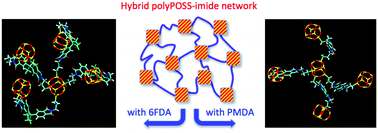The influence of the dianhydride precursor in hyper-cross-linked hybrid polyPOSS-imide networks†
Abstract
Hybrid organic/inorganic hyper-cross-linked membranes based on imides covalently bonded with polyhedral oligomeric silsesquioxanes (POSS) have recently been developed for gas-separation applications under high pressure and/or temperature conditions. Their molecular sieving capabilities have been shown to depend on the nature of the organic dianhydride precursor. In the present work, realistic molecular models of such polyPOSS-imide films based on the flexible 6FDA dianhydride are compared to those based on the shorter and more rigid PMDA dianhydride. The models creation procedure closely mimicks the mixing, polycondensation and imidization steps of the experimental scheme. The resulting networks are found to be highly heterogeneous in terms of both the number of links (from zero to the maximum possible of eight per POSS cage with an average of four) and their structure (interPOSS, intraPOSS, single-links, double-links) because of the eight-equivalent-arms nature of the POSS precursor. For both dianhydride precursors, crosslinking with POSS and the subsequent imidization step decrease the density, create additional void-space and increase the solubility of the resulting membranes. However, when compared to PMDA, the added flexibility of the central 6FDA bridge leads to a larger thermally-induced dilation of the networks and a larger volume loss per H2O over the imidization step. With their better ability to redensify and to adapt to the added constraints, the cage⋯cage distances and cage⋯(organic bridge)⋯cage angles in the 6FDA polyPOSS-imides span a larger range than in their PMDA counterparts. In addition, the stiffness of the PMDA moiety results in more unrelaxed free volume remaining trapped in the PMDA polyPOSS-imides upon imidization, and as such, to significantly more open structures with less favourable interactions. As expected from their enhanced flexibility, the thermomechanical properties of the 6FDA networks are slightly lower than those based on PMDA. However, the better mechanical resistance of PMDA over 6FDA does not really become significant before very large volume dilations.


 Please wait while we load your content...
Please wait while we load your content...